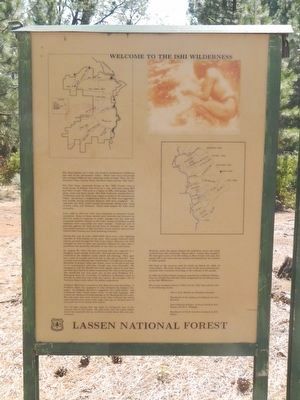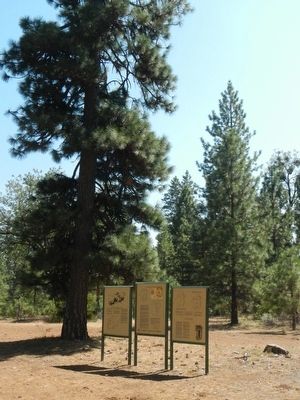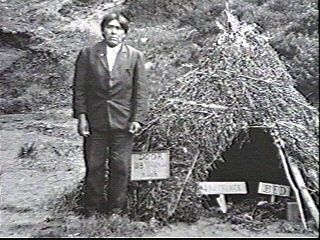Near Butte Meadows in Tehama County, California — The American West (Pacific Coastal)
Welcome to the Ishi Wilderness
Inscription.
The Yana Indians are a tribe who lived in northeastern California just east of the Sacramento Valley. There were four sub-groups who occupied different but adjoining tracts of land. They are the Northern Yana, Central Yana, Southern Yana and the Yahi Yana.
The Yahi Yana, commonly known as the "Mill Creeks" were a small group of Indians who lived in a very wild area along Mill and Deer Creeks. This area is a region of cliffs, wild gorges, dusky glens, caves and dense brush. The Yahi lived here undisturbed by civilization until the white man began to settle in the Sacramento Valley. According to neighboring tribes, the Yahi were aggressive and warlike having continual disputes with their neighbors. Occasionally the Yahi raided remote homesteads taking every scrap of food, cloth, and livestock. These raids helped the Yahi avoid starvation.
From 1860 to 1870 the Yahi were subjected to numerous brutal massacres. Some of these attacks were directed and financed by the U.S. Army in response to public outrage over the raids and occasional murders blamed on the Yahi. Groups of settlers or paid vigilantes were responsible for other attacks. Continual acts of genocide against the Yahi forced them to withdraw to the most inaccessible portions of Mill and Deer Creek canyons and severely limited their hunting and food gathering territory.
During the next 40 years (1870-1910) there were a few sightings reported of wild Indians in the area. Few people believed these reports, as most thought the Yahi to be extinct. However, the Yahi managed to exist in their own primitive lifestyle for more than a generation but gradually dwindled to less than six individuals.
On August 29, 1911, the last surviving Yahi was captured at a slaughter house outside of Oroville. The men discovered him crouched in the shadows nearly naked and starving. They have him a pair of overalls and took him to the jail in Oroville. The curiosity surrounding the last "wild Indian" in California was great. Hundreds of people, white and Indian, came to the jail to see and try and communicate with him; though none were successful. He managed to tell the Sheriff with hand signals where he was from and that there had been three companions who died on the journey. The sheriff fed and took good care of him until Professor T.T. Waterman from the University of California at Berkeley came to Oroville to meet him and verify the reports. He brought a list of Northern Yana words which the Indian understood.
Professor Waterman returned to San Francisco with the Indian. A Northern Yana was employed to help interpret the Indian's language. At Professor Kroeber's suggestion the "wild Indian" was nicknamed "Ishi" which means "man" in the Yahi language.
It lived at the Museum of Anthropology at UC Berkeley for five years. His real name was never learned as the Yana believed the actual name carried much power and magic and was an intimate part of one's self not to be shared with others.
One of many outing Ishi was taken on during his stay at the museum was to the beach. He had never seen the ocean before and it was expected that he would be excited about this new phenomenon.
However, when the group reached the bluff from where the beach could be seen, Ishu exclaimed, "Bansi saltu!" (many white people!). He spent most of his life hiding on Deer Creek with only five people left in his tribe and was amazed and alarmed by the number of white people.
It lived at the museum until his death on March 25, 1916, of tuberculosis. His body along with some of his most personal possessions, were cremated according to the custom of his people.
In 1984 the United States Congress enacted the California Wilderness Act (Public Law 98-425) which designated the 41,100 acre area as Ishi Wilderness.
For a more complete history of Ishi and the Yahi Yana please refer to the following books:
It in Two Worlds by Theodora Kroeber
Handbook of the Indians of California by A.L. Kroeber
The California Indians: A Source Book by R.F. Heizer and M.A. Whipple
Handbook of North American Indians by R.F. Heizer
Erected by Lassen National Forest.
Topics. This historical marker is listed in this topic list: Native Americans. A significant historical date for this entry is August 11, 1911.
Location. 40° 8.094′ N, 121° 42.396′ W. Marker is near Butte Meadows, California, in Tehama County. Marker is on Lassen Trail (Forest Road 27N08) near California Route 32, on the right when traveling south. Touch for map. Marker is in this post office area: Forest Ranch CA 95942, United States of America. Touch for directions.
Other nearby markers. At least 8 other markers are within 9 miles of this marker, measured as the crow flies. Lassen Trail - Unrecognizable Emigrants (a few steps from this marker); History of the Lassen Trail (a few steps from this marker); Lassen Trail - Bruff's Camp (approx. 2.6 miles away); Bruff's Camp (approx. 2.6 miles away); Lassen Trail - The Narrows (approx. 3.4 miles away); Lassen Trail - Mill Creek Overlook (approx. 7.2 miles away); Lassen Trail - The Last Summit (approx. 8.6 miles away); Katie Thompson – Mattie Thompson – Josie Campbell (approx. 9 miles away). Touch for a list and map of all markers in Butte Meadows.
More about this marker. There are no signs identifying Forest Service Road 27N08 or Lassen Trail. This marker is about 22 miles from Highway 32 on Forest Service Road 27N08
Also see . . . Ishi, last 'wild' Indian, found refuge in S.F. - SF Gate . For 4 1/2 years, a unique saga played out on San Francisco's Parnassus Avenue. On that lofty street at the base of Mount Sutro, overlooking Golden Gate Park, Marin and the Farallon Islands, the last "wild" Indian in North America, Ishi, spent his final years living in a museum where he was looked after, and befriended, by California's most eminent anthropologist. (Submitted on September 2, 2015, by Barry Swackhamer of Brentwood, California.)
Credits. This page was last revised on June 16, 2016. It was originally submitted on September 2, 2015, by Barry Swackhamer of Brentwood, California. This page has been viewed 741 times since then and 39 times this year. Photos: 1, 2, 3. submitted on September 2, 2015, by Barry Swackhamer of Brentwood, California.


